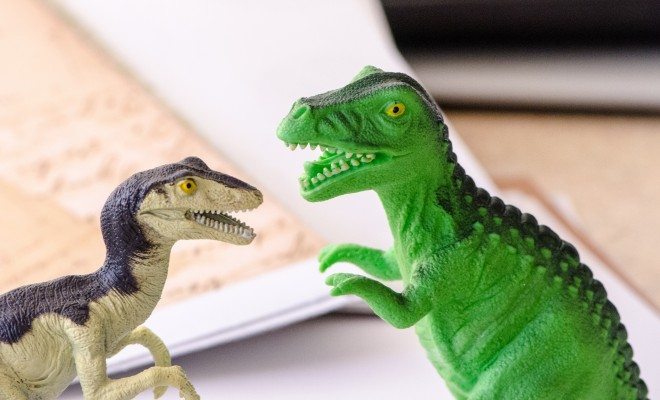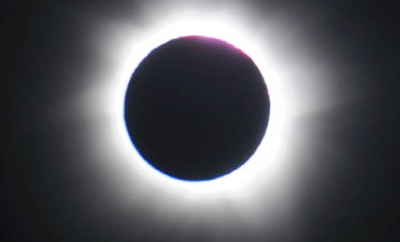 Image courtesy of [m01229 via Flikr]
Image courtesy of [m01229 via Flikr]
Health & Science
Jurassic Park Realism: What Do We Really Know About Dinosaurs?
Dinosaurs are hard to keep up with despite their extinction more than 65 million years ago. We discover a new dinosaur about every two weeks. Yet experts estimate only 28 percent of dinosaurs that existed have been identified. Frequent findings bring these animals to life, providing us with clues on how they might have looked and lived.
With these fast-paced discoveries, it should come as no surprise that the original Jurassic Park featured outdated dinosaurs. Audiences were expecting to see some tweaks in the look of the creatures in the forthcoming Jurassic World movie set to release in June 2015.
Disgruntled experts claim the dinosaurs appearing in the trailer are “stuck in the 1980s.” Jack Horner, paleontologist and scientific consultant on the film, isn’t worried. He states that the movie is purely fiction, not a documentary.
As someone who hasn’t given much thought to dinosaurs since elementary school, the outcries made me curious. How much do we really know about them? How do we even know what we do know? I explore these questions below.
How much can you find out from a bone?
Fossils go beyond bones to include anything that provides evidence of prehistoric life. They can be physical remains, trace remains (footprints and teeth marks), animal feces, pollen, spores, or even ripple marks from a long-dry prehistoric ocean.
The paleontologists who study fossils incorporate computer science, archaeology, biology, geology, ecology, anthropology, and more to explore evidence of the past. Like investigators on a crime scene, they detect clues where most people would see rubbish.
What do they look at?
- Microscopic fossils. They’re small but make up a large proportion of fossils just as microorganisms make up a large proportion of biomass.
- Traditional fossils. These include imprints, bones, shells, molds, exoskeletons, and other petrified remains of ancient life.
- Plant fossils. These reveal much about prehistoric lifestyles and ecologies.
- Plant spores. Plant spores, or palynomorphs, resist decomposition better than other types of fossils. Due to their resistance to decomposition, they’ve been useful in oil and gas exploration.
- Trace fossils. The study of trace fossils, or ichnology, focuses on tracks, footprints, and trails. Since many animals don’t leave behind anything that will fossilize, trace fossils provide the best evidence of how ancient creatures lived.
- Formation of fossils. Taphonomy is the study of how and why fossils form.
How do they study the fossils?
Fossils are rare, fragile, and require meticulously attentive handling. New, high-resolution X-ray computed tomography (CT) enables scientists to create complete and detailed scans of fossils so they can be examined in new ways by many people without fear of damage. The scans operate like extremely powerful medical X-rays that produce unbelievably vivid images.
To tout the benefits of the technology, Dr. Timothy Rowe uses the example of a dinosaur skull. With the scan, he can cut apart the skull digitally, without harming the fossil to explore different structures that might indicate how its brain worked and so much more.
The Fossil Record: An Incomplete Puzzle
The collective pieces of the dinosaur puzzle are called the fossil record and it’s definitely missing some pieces.
Producing fossils requires rare conditions. Most animals were eaten, leaving nothing behind to fossilize. Many animals and entire animal groups, like soft-bodied and small-boned organisms, never became fossils. Furthermore, wind and water erosion often swept away buried remains, especially in mountainous areas.
So while we know a great deal from what clues we do have, the clues are patchy. One scientist even estimated that only 2,100 adequate dinosaur skeletons exist. It’s extremely rare to find a whole dinosaur skeleton.
How do we figure out what they looked like?
The Basics
Using clues from the past and knowledge of modern animals, scientists make educated guesses about what dinosaurs may have looked like.
All reconstructions start with the foundation–the skeleton. It’s rare to find a complete skeleton, so scientists piece together an anatomically correct dinosaur from what fragments and pieces they have along with their knowledge of modern animals. Body parts made from cartilage are never fossilized; we can recreate skeletons, but we don’t know with absolute certainty how their joints moved.
After the skeleton comes the meat and muscle. Markings on the fossils where muscles were attached indicate their past location and size. The fossils tell them where the muscles should go, and studying modern animals helps them determine how much muscle mass to add.
The Embellishments
After the basic shapes come the embellishments: skin, colors, feathers, and more. Reconstructing these embellishments is less of an exact science since there is typically less evidence.
- Skin. A fossil is rarely surrounded by impressions made by the animal’s skin. If found, the impressions provide good indication of skin texture.
- Armor. Plates and spikes are fossilized easily relative to other features. When found with good skeletons, scientists can get a clear picture of how the armor might have been arranged on the body.
- Feathers. Fossils have shown impressions that indicate theropod (beast-footed) dinosaurs had feathers or feather-like structures. And a Siberian unearthing presents compelling evidence that other dinosaurs, and not just theropods, were feathered. The finding was significant because it contained the remains of many different ancestrally distinct species with feather imprints. It suggests that almost all dinosaurs had some kind of feathers. Even skeletons of the fierce and familiar Velociraptor have been found with quill knobs similar to what anchors feathers to the bones of modern birds. While the absence of these knobs doesn’t indicate a lack of feathers, their presence almost certainly confirms the feathers existed.
- Color. A rare feather fossil has been found that contains two types of the organelles that pigment hair, skin, and feathers called melanosomes. They two types were: elanosomes, which give zebras their stripes; and phaeomelanosomes, which make human hair red. The findings suggest that the particular Sinosauropteryx studied had a dark orange striped tail. A breakthrough like this is rare, so many artists are free to take license when choosing how to color their depictions.
How does dinosaur science affect dinosaur art?
Artists do what they can to make their depictions as accurate as possible, but because new developments happen so frequently and art takes time, renditions become outdated at a fast pace.
Thomas Holtz, a University of Maryland paleontologist, walks through some depictions of dinosaurs featured in past issues of National Geographic Magazine to call out what would now be different in artist renditions. Here are just a few examples:
- Many old dinosaur depictions feature them dragging their tails, yet we haven’t found any trace fossils of tail drag marks. Scientists believe that dinosaurs kept their tails upright and above the ground.
- Early dinosaur art often shows them in upright postures similar to humans. We now know such an upright posture is unlikely for any dinosaur–most of them moved in a nearly horizontal fashion.
- Depictions of a blunt-headed Brontosaurus are invalid. Brontosaurus was actually found to be simply a type of Apatosaurus and had a long, tapered skull.
New discoveries happen every day. The dinosaur toys kids are playing with in a handful of years will probably look completely different from the ones we enjoyed.
What’s new in dino world?
Dinosaur knowledge updates come fast and frequent. Here’s some of the latest dinosaur news.
- Researchers used computational fluid dynamics to create the first model of dinosaur breathing. The study suggests that dinosaurs had such long snouts to accommodate very deep breaths and lots of mucus. The mucus kept foreign particles out of their nostrils and the deep breaths cooled the blood to prevent their brains from overheating.
- A new pot-bellied dinosaur almost as big as Tyrannosaurus Rex was found. The strange new creature, Deinocheirus, had a large belly, big feet, and a sizable beak instead of teeth.
- A peculiar puncture wound in an Allosaurus suggests that Stegosaurus might have used its spiked tale to strike hungry predators below the belt.
- A nearly whole skeleton of what might be the largest terrestrial animal ever was discovered. Dreadnaughtus would have been about the size of a dozen elephants and seven times the size of a Tyrannosaurus Rex. Its bones reveal the particular animal might have been growing at the time of death.
A Mysterious Future For a Long-Dead Animal
As I mentioned earlier, of all the dinosaur bones that probably exist, only 28 percent have been identified. The potential for future discovery is huge. Even questions that seem simple remain mysterious to us. Were dinosaurs hot blooded or cold blooded? How did they mate? Why did they have horns, spikes, armor, or feathers? We still don’t even know exactly how they all went massively extinct.
The new Jurassic World trailer inspired me to look into what we know about dinosaurs. I found that we know quite a bit, but have much left to learn. Now I’m just wondering what new information we’ll have by the time the movie is released in June.
Resources
Primary
Smithsonian: Dinosaurs in the Backyard: How Do We Know?
Idaho Museum of Natural History: What is a Fossil?
Smithsonian: Reconstructing Extinct Animals
Additional
The New York Times: Many More Dinosaurs Still to Be Found
National Geographic: ‘Jurassic World’ Dinosaurs Stuck in the 1980s, Experts Grumble
Science Mag: Feather Quill Knobs in the Dinosaur Velociraptor
Pubmed: An Early Cretaceous Heterodontosaurid Dinosaur With Filamentous Integumentary Structures
National Geographic: Siberian Discovery Suggests Almost All Dinosaurs Were Feathered
Nature: Fossil Feathers Reveal Dinosaurs’ True Colours
National Geographic: What’s Wrong With This Picture? An Audio Critique
Scientific American: New “Dreadnought” Dinosaur Most Complete Specimen of a Giant
Teachers: Unearthing Dinosaur Bones and Fossils
Carlton College: Taphonomy: The Study of Preservation








Comments